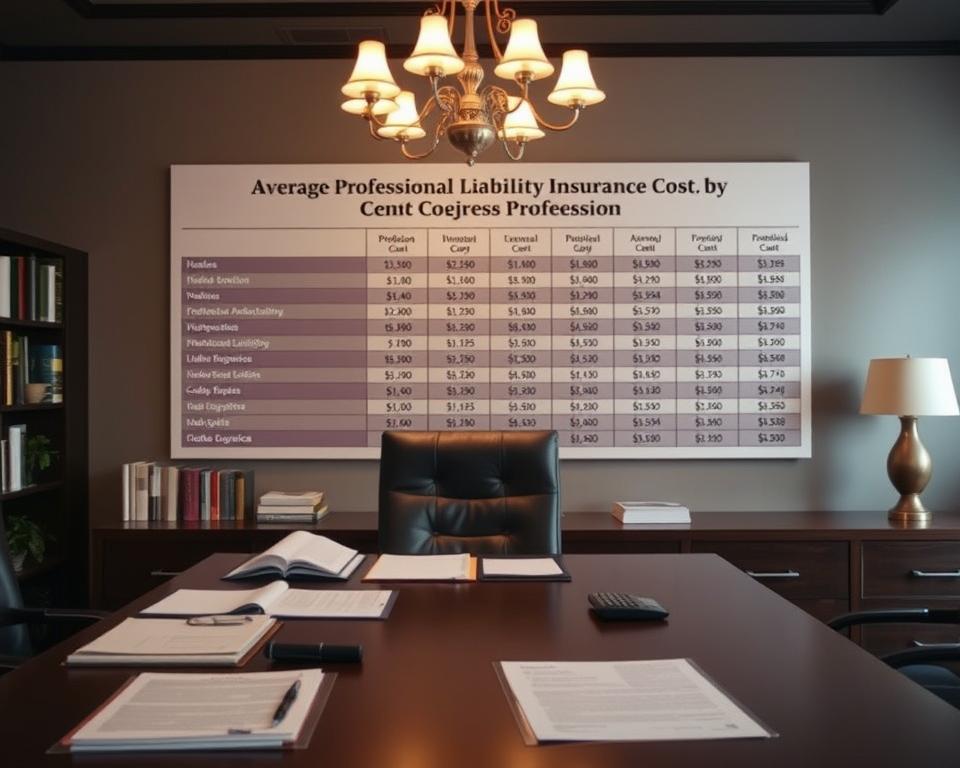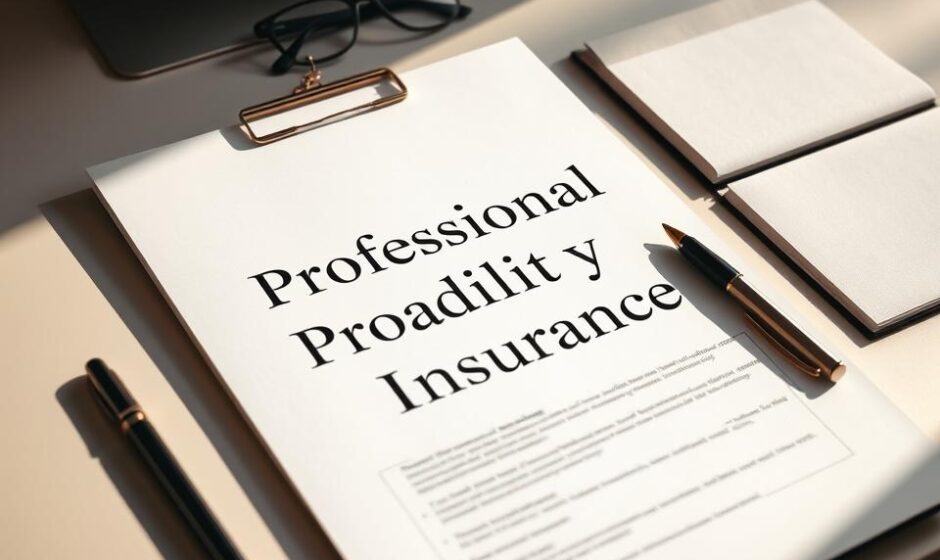One in three U.S. businesses faces a professional liability claim each year. The average legal defense costs are over $150,000, even if the claim is unfounded. Professional liability insurance (PLI) acts as a financial shield against these risks.
It covers errors, omissions, and negligence claims that can harm a business. This coverage is different from general liability insurance. It focuses on professional services, not physical property damage.
For service providers, like healthcare and tech consultants, PLI protects against lawsuits. These lawsuits can arise from advice, designs, or advice delivered improperly.
Key Takeaways
- Covers legal defense costs, settlements, and expenses from client disputes over professional mistakes.
- Required by law for professions like healthcare, legal services, and financial advising.
- Excludes intentional misconduct, bodily injury, or property damage claims.
- Uses a “claims-made” system, requiring continuous coverage to avoid gaps in protection.
- Offers extended reporting options for claims reported after policy expiration.
What is Professional Liability Insurance?
Professional liability insurance, also called errors and omissions insurance, protects businesses from financial loss due to professional mistakes. It covers claims of negligence, errors, or poor service quality. For example, a bookkeeper’s mistake or a web developer’s coding error can lead to expensive lawsuits. This insurance helps cover these costs.

How Professional Liability Insurance Protects Your Business
Key protections include:
- Legal defense costs for claims alleging professional mistakes
- Settlements or judgments up to policy limits
- Coverage for service-related disputes, such as tax filing errors or contract breaches
Professional Liability vs. General Liability Coverage
Unlike general liability, which covers physical harm or property damage, professional liability targets service-related risks. Here’s how they differ:
| Category | Professional Liability | General Liability |
|---|---|---|
| Primary Risks | Mistakes in services (e.g., missed deadlines, incorrect advice) | Slip-and-fall accidents, customer injuries |
| Coverage Type | Errors and omissions | Property damage, bodily injury |
Key Components of a Professional Liability Policy
Every professional liability policy includes:
- Policy type: Occurrence (covers incidents during the policy period) or claims-made (requires claims to be filed while coverage is active)
- Retroactive date: Determines when coverage begins for past actions
- Extended Reporting Period (ERP): Optional add-on costing twice the last premium to extend claim windows after policy cancellation
For example, an accountant with a claims-made policy must keep coverage active to stay protected. If they don’t renew, their past work could be at risk.
Who Needs Professional Liability Insurance?
Professional liability insurance isn’t just for big companies. Small businesses, freelancers, and service firms of all sizes need it. If you advise clients, design solutions, or offer specialized services, this insurance protects you. It covers financial risks from errors or omissions.

- Accountants and tax preparers: Errors in filings or advice can lead to lawsuits.
- Designers (graphic, interior, architectural): Client disputes over work quality or delays may trigger claims.
- Consultants and engineers: Mistakes in recommendations or project execution can result in financial losses for clients.
- IT and tech professionals: System failures or data breaches may require professional indemnity insurance to cover liability.
- Real estate agents: Errors in contracts or property evaluations could lead to liability claims.
States require liability insurance for doctors and lawyers. Even if not required, clients often ask for proof of professional liability insurance before signing contracts. Freelancers and startups face the same risks as big companies. If your work involves client trust and deliverables, this insurance protects your assets from lawsuits.
Whether you’re a solo architect or a marketing agency, professional indemnity insurance lets you grow without fear of financial ruin from avoidable claims.
Industries Most at Risk Without Professional Liability Coverage
Not all jobs are created equal when it comes to legal risks. Some jobs are much more likely to face lawsuits. Here are some industries where getting professional liability insurance is key to avoid financial disaster.

Healthcare Professionals and Malpractice Insurance
Doctors, nurses, and therapists need to guard against negligence claims. Malpractice insurance helps cover lawsuits for bodily harm, like if a patient says they got hurt because of bad care. For example, a massage therapist might face a lawsuit if a client says they got hurt during a session. These policies usually start at $2,500 a year for small practices.
Legal Professionals and Errors and Omissions Insurance
Lawyers often deal with claims about missed deadlines or bad legal advice. Errors and omissions insurance (E&O) helps protect against these issues. This could be things like messing up an estate case or forgetting to file documents on time. Solo attorneys usually pay $1,200–$3,000 a year for this insurance.
Financial Advisors and Professional Indemnity Insurance
Financial advisors who give investment advice need professional indemnity insurance. This insurance covers losses from bad advice, like suggesting the wrong stocks. If a client sues over losses in their retirement portfolio, this insurance can help. Coverage starts at $1,500 for advisors making less than $1M a year.
Technology Consultants and IT Liability Coverage
IT consultants who handle client data need insurance for data breaches or system failures. Imagine a security flaw causing a data leak—this insurance pays for legal costs and settlements. Tech companies also buy this insurance along with malpractice insurance to cover project failures or software bugs.
- Healthcare: $2,500–$5,000 average annual premium
- Legal: $1,200–$3,000 for solo practitioners
- Financial: $1,500+ based on client count
Without these specific policies, businesses risk losing everything and their reputation. Getting both professional liability and general liability insurance creates a strong defense against specific claims in each industry.
Understanding the Cost Factors of Professional Liability Insurance
Professional liability insurance costs vary a lot. Knowing what affects these costs helps businesses plan their budgets better.

Industry-Specific Risk Factors
- Fields like accounting or law often have higher premiums because of the risk of claims.
- Jobs in landscaping or consulting might have lower rates compared to riskier fields.
Business Size and Revenue Considerations
Larger companies with more employees or higher revenue usually pay more. They might need more professional liability coverage to cover their risks.
- States with strict laws can make insurance more expensive because of lawsuit costs.
- New businesses without a track record might pay more at first.
Claims History Impact on Premiums
A company’s past claims history affects its insurance costs. A history of lawsuits or errors can increase premiums. But, a clean record can lower costs.
Coverage Limits and Deductible Options
Choosing higher coverage limits (like $2 million instead of $250,000) means higher monthly costs. A higher deductible (like $1,000 instead of $500) can lower premiums but means you pay more out-of-pocket during claims.
The average cost for professional liability insurance is $61 a month. Businesses can look for affordable options. Check out business liability insurance quotes from GEICO to find savings that fit your industry and risk level.
Average Professional Liability Insurance Costs by Profession

Healthcare providers, lawyers, and financial advisors face different risks. Here’s how costs compare:
| Profession | Median Monthly Cost | Notes |
|---|---|---|
| Healthcare Professionals | $45–$120 | Malpractice insurance often highest due to high-risk procedures. |
| Legal Professionals | $30–$75 | Varies with practice area and years of experience. |
| Financial Advisors | $25–$50 | Based on assets managed and client count. |
| Real Estate Agents | $20–$40 | Lower risk compared to other industries. |
Data from NEXT shows 55% of customers pay under $25/month, while 79% pay between $25–$45. National averages from Progressive in 2023: $42 median, $64 average monthly.
- Healthcare: $45–$120/month (malpractice insurance)
- Legal: $30–$75/month
- Financial: $25–$50/month
Costs vary by industry, location, and coverage limits. A $50,000 limit might cost $30/month, while $1 million could double premiums. Claims history also impacts pricing—new businesses may pay more initially.
Choosing the right professional liability policy requires balancing coverage needs with budget. Even small firms in low-risk fields like real estate spend $20–$40 monthly to secure professional liability coverage against client disputes or errors.
Compare quotes from multiple insurers to find a policy matching your business’s risks. Avoid underinsuring—over 80% of claims involve service failures costing $10,000+, per industry studies.
Common Claims Covered by Professional Liability Insurance
Professional liability insurance protects businesses from financial loss due to client accusations of professional errors. It covers mistakes, omissions, and professional duty breaches, even if claims are later found to be false. Here are examples where such policies have been crucial.

Negligence and Professional Mistakes
- A construction firm faced a $2 million lawsuit after a design flaw caused building collapses, covered under professional liability insurance.
- Architects sued for faulty blueprints or engineers blamed for material failures qualify for defense and settlement costs.
Misrepresentation and Errors
- A tax preparer’s incorrect advice leading to IRS penalties may be covered under a professional liability policy.
- False advertising or incorrect financial forecasts by consultants can trigger claims addressed by coverage.
Breach of Confidentiality
- Lawyers or therapists sued for leaking client data may use coverage for settlements and legal fees.
- Healthcare providers mishandling patient records or tech firms exposing client data qualify.
Failure to Deliver Services
- A contractor’s delayed project leading to client losses may be covered if contract terms were unmet.
- Graphic designers failing to meet deadlines or IT consultants missing project milestones could trigger claims.
| Claim Type | Example | Insurance Response |
|---|---|---|
| Negligence | Structural defects in a 20-year-old building | Defense costs and settlement funds up to policy limits |
| Misrepresentation | Incorrect tax filing causing IRS penalties | Pays client restitution and legal fees |
| Breach of Contract | Unfinished construction project | Covers lost profits claims from clients |
Exclusions include intentional harm, sexual misconduct, or property damage covered under general liability. Always review policy details to ensure alignment with your industry’s risks. A liability insurance for professionals must clearly outline its scope to avoid coverage gaps.
How to Choose the Right Professional Liability Policy for Your Business
Choosing the right professional liability policy means making decisions that fit your business’s specific risks. First, look at your industry’s risks. For example, tech companies need coverage for software bugs or data breaches. Architects need protection for design mistakes.

Evaluating Your Specific Risk Profile
Start by figuring out the risks in your field. Healthcare providers worry about malpractice, while consultants worry about bad advice. Think about past claims, client contracts, and the size of your projects. For example, companies with big contracts might need more coverage.
- Industry Standards: Architects, engineers, and IT firms face unique risks that need special coverage.
- Client Contracts: Check your agreements for coverage limits or specific endorsements.
- Historical Claims: Past disputes can change how much you pay and what options you have.
Selecting Appropriate Coverage Limits
Choose coverage limits based on how much you could lose. A small marketing firm might start with $1M limits. But a construction firm building skyscrapers will need more. Contracts often require a minimum amount of coverage.
Also, tech companies need cyber liability add-ons to protect client data.
Understanding Policy Exclusions and Limitations
Look at what’s not covered, like bodily injury or intentional misconduct. For example, errors and omissions insurance doesn’t cover fraud or employment law breaches. Make sure you know what’s not covered, like global operations needing worldwide coverage.
Compare quotes from companies like Chubb or The Hartford. Ask brokers about discounts for multiple policies. Choose insurers that help before claims happen. A good professional liability policy balances cost with protection against your industry’s risks.
Steps to Purchase Professional Liability Insurance
Getting professional liability insurance needs careful planning and clear steps. First, gather all your business documents, like licenses and financial statements. Insurers look at your revenue, employee count, and claims history to figure out what you need. 
- Assess Coverage Needs: Look for any gaps in your current policies. People in healthcare, law, or finance often need special professional liability coverage because of their risks.
- Compare Quotes: Use sites like biBerk to see different prices. Things like how long you’ve been in business, where you are, and how much you make affect the cost. Solo lawyers might get discounts in their first three years.
- Submit Application: Share information like how much you make each year, your client contracts, and agreements with subcontractors. Tell them about any past claims and your policy history to avoid missing coverage.
- Review Policy Details: Check what’s not covered, any deductibles, and how much you’re covered for. Make sure the policy fits your risks, like data breaches or client disputes.
“biBerk offers professional indemnity insurance in all U.S. states except Hawaii, with tailored options for firms of any size.”
Finally, pick how you want to pay and how long you want the policy to last. New businesses might get lower rates at first, while bigger firms can negotiate based on their clean claims history. Always check the policy details to make sure it meets state laws. For personalized advice, talk to an agent who can help you find the right professional liability insurance for your business.
Conclusion: Protecting Your Professional Future with Liability Insurance
Professional liability insurance protects professionals from unexpected claims. These claims could harm their careers. In today’s world, even false claims can cost a lot and damage reputations.
This insurance gives professionals legal defense. It helps them avoid expensive judgments and settlements. For doctors, lawyers, financial advisors, and tech experts, it’s a must-have.
Policies vary a lot. Costs can be from $1,000 to $5,000 a year. This depends on the industry and business size. A good policy fits your needs, covering remote work and changing service standards.
It keeps your finances and reputation safe. This helps you stay competitive and trusted in your field.
Without liability insurance, small mistakes can ruin your finances. Defending against a lawsuit can cost over $100,000. So, planning ahead is key.
By getting professional liability insurance, you show you’re responsible to clients. It’s not just about avoiding claims. It’s about growing and staying stable in the long run.
Choosing the right coverage is smart for your career. Look into different policies to keep your business safe from unexpected risks. Liability insurance lets you focus on your success, not on fighting lawsuits.



